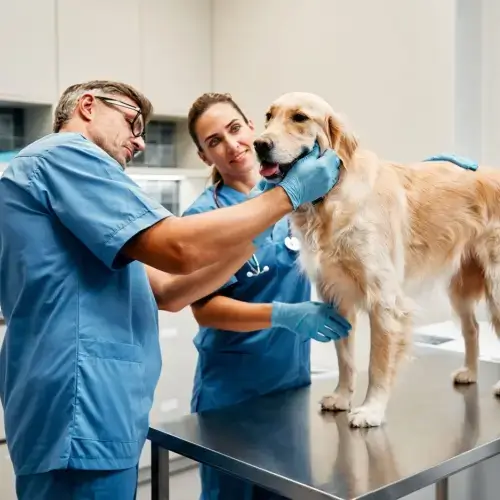Home / Compare Pet Insurance / Arthritis in dogs

Key takeaways
- Arthritis in dogs is a chronic condition that leads to joint pain, inflammation and decreased mobility. Regular check-ups and early symptom detection can help manage the condition.
- Managing arthritis involves weight control, low-impact exercise, joint supplements, physical therapy and medications. Treatments like NSAIDs, injections and alternative therapies (e.g. acupuncture) can also help reduce pain and inflammation.
- Comprehensive pet insurance may cover arthritis treatments, including medications, surgeries and alternative therapies and help to maintain your dog’s quality of life.
What is arthritis in dogs?
 Arthritis in dogs, also known as osteoarthritis (OA) or degenerative joint disease (DJD), is a chronic condition that affects the joints and ligaments. It causes joint pain, inflammation, and a decreased range of motion.1
Arthritis in dogs, also known as osteoarthritis (OA) or degenerative joint disease (DJD), is a chronic condition that affects the joints and ligaments. It causes joint pain, inflammation, and a decreased range of motion.1
Risk factors that may contribute to arthritis in dogs include ageing, congenital joint disorders such as hip dysplasia, osteochondrosis, and elbow dysplasia, old injuries, repeated joint trauma, activity levels in working and athletic dogs that put additional strain on joints, obesity and metabolic diseases such as diabetes and Cushing’s disease.1
Pet owners should learn how to spot the signs of arthritis, how the disease progresses and how to manage it so their pet can continue to lead a happy and comfortable life.
How do I tell if my dog has arthritis?
Arthritis is diagnosed through physical examinations, X-rays, blood tests and observing your dog’s movement.1 Regular check-ups are essential, particularly for senior dogs or large breeds prone to joint issues (e.g. Labrador Retrievers, German Shepherds). You can also identify symptoms of arthritis at home by observing your dog to catch the following symptoms early.2
Reduced activity
Dogs with arthritis often show decreased interest in activities they once enjoyed, such as running and fetching. They may seem more tired than usual and may not want to go walking or play with other dogs.
Limping or stiffness
Limping is common and may vary in severity depending on the time of day or recent physical activity. Dogs may also have difficulty climbing stairs or jumping onto furniture.
Difficulty standing or lying down
Arthritic dogs may struggle to rise from a lying or sitting position. Similarly, they may hesitate or take longer to lie down, trying to find a comfortable position.
Behavioural changes
Arthritis pain can make dogs irritable, anxious or withdrawn. They may avoid being touched in certain areas, yelp or show signs of aggression due to pain.
Swollen joints
Inflammation often leads to visible swelling or warmth around the affected joints.
Losing muscle mass
Reduced use of the affected limbs can lead to noticeable muscle wasting over time, especially in the hips and hind legs.
How long can dogs live with arthritis?
Dogs with arthritis can live their everyday lives if they receive proper care, but there is no complete cure.3 Rather than treating the disease, the focus should be on managing symptoms and ensuring your dog remains as pain-free and mobile as possible.3 Regular check-ins with your vet can help tailor treatment options to your dog’s needs. The overall prognosis depends on various factors, including:
- Severity of arthritis: Mild cases, when managed well, may have minimal impact on life expectancy. Severe cases may require more intensive management.
- Age and breed: Older dogs and larger breeds may have shorter lifespans regardless of arthritis, but effective treatment can still improve their quality of life.
- Management and care: Dogs receiving proper treatment, regular exercise, and a balanced diet can live comfortably for years after diagnosis.
What are the four stages of arthritis in dogs?
Progression of arthritis is very gradual through four stages, and although the disease may be harder to spot in the earlier stages, knowing what to look out for and being able to identify the symptoms as soon as possible can help your dog lead a long, comfortable life.4
Stage 1: Early arthritis
- Minimal joint damage
- Mild stiffness that may be attributed to ageing
- Dogs may appear slightly slower after vigorous exercise.
Stage 2: Moderate arthritis
- Visible symptoms, including occasional limping and difficulty moving
- Reduced willingness to engage in physical activities
- Swelling and mild pain may be present.
Stage 3: Advanced arthritis
- Significant joint degeneration
- Chronic pain and noticeable difficulty moving or resting
- Increased stiffness, even after short periods of rest
- Muscle atrophy becomes apparent.
Stage 4: Severe arthritis
- Severe pain and joint deformities
- Lameness (difficulty walking), climbing stairs or standing without assistance
- Dogs may require constant pain management and support.
Managing arthritis in dogs
There is no cure for arthritis. Controlling the joints’ inflammation is essential to reducing arthritis-related pain and careful management can delay advancement. Management involves a combination of lifestyle adjustments and treatments such as.5
Weight management
Excess weight puts added stress on joints so a balanced diet and portion control are essential. If your dog is suffering from obesity, ask your vet about weight loss plans to get it to a healthy weight.
Low-impact exercise
Activities like swimming or short, controlled walks help maintain muscle strength without straining joints. Avoid high-impact exercises.
Joint supplements
Products containing glucosamine, chondroitin and omega-3 fatty acids (like fish oil) can improve joint health by promoting cartilage repair and reducing joint degeneration. Consult your vet for recommended brands and dosages.
Physical therapy
Techniques like hydrotherapy, massage and stretching exercises can help improve mobility and reduce stiffness.
Home adjustments
Provide orthopaedic bedding for extra joint support, and consider using ramps or non-slip mats to help your dog navigate stairs or slippery floors.
What is the treatment for dog arthritis?
Treatment plans vary based on the severity of arthritis but typically include:6
Medications
Non-steroidal anti-inflammatory drugs (NSAIDs) may relieve pain and reduce inflammation but should only be used under veterinary guidance. Pain relieving medications like gabapentin or tramadol can also be prescribed for chronic pain.
Dietary adjustments
Nutraceuticals and prescription diets formulated for joint health may include anti-inflammatory ingredients like omega-3 fatty acids.
Alternative therapies
Acupuncture and laser therapy can complement traditional treatments, relieving pain and reducing inflammation in your dog’s joints.
Surgery
In severe cases, surgical options such as joint replacement or arthroscopy may be necessary.
Dog arthritis injections
Injections offer targeted pain relief for arthritic dogs and can help reduce joint inflammation, enhance your pet’s body condition and offer relief for your dog’s joints with minimal side effects.7 Injections for your dog’s arthritis may help with joint fluid production and blood circulation, making your pet more comfortable. They can also help protect the joint cartilage by stimulating new fluid production and thickening the joint fluid to improve lubrication.
Does pet insurance cover arthritis treatment for dogs?
Pet insurance is a valuable option for managing chronic conditions like dog arthritis as arthritis treatment often involves ongoing costs, including medications, radiographs, supplements, physiotherapy and potential surgeries.
Depending on the insurer and policy type, most comprehensive pet insurance policies cover a percentage of these expenses, which can ensure your dog gets the necessary care without financial strain. Insuring your dog early is crucial because pre-existing conditions, such as arthritis diagnosed before coverage begins, are typically not covered. Here are some things to note when selecting a policy with arthritis cover.
Pet insurance arthritis cover

- Many comprehensive plans cover canine arthritis, as it is considered a chronic condition.
- Policies often cover diagnostic tests, medications (like NSAIDs), injections and physical therapies (e.g. hydrotherapy).
- Advanced cases of arthritis may require surgery, such as joint replacement or arthroscopy, which can cost thousands of dollars. Pet insurance that offers surgical cover can help.
Alternative therapies and supplements
- Some plans may include cover for alternative treatments like acupuncture, laser therapy and chiropractic care.
- Certain policies may also reimburse for veterinarian-prescribed supplements.
Lifetime limits and caps
- Some policies have annual or lifetime payout caps, meaning they only cover expenses up to a certain amount.
- Opt for a policy with higher or unlimited limits if arthritis or other chronic conditions are a concern.
When should I get pet insurance that covers arthritis for my dog?
Getting insurance when your dog is young and healthy can help to ensure they’re covered for future arthritis-related costs and help with early detection through regular vet visits. Early enrolment into a pet insurance plan can also mean lower premiums and protection against breed-specific or genetic predispositions to joint issues. With the right policy, you can focus on your dog’s health and comfort, knowing treatments, therapies and even surgeries will be supported financially.
Always read your Product Disclosure Statement (PDS) and the Target Market Determination (TMD) to understand what is and isn’t covered by your policy and determine whether the product is right for you.
Meet our pet insurance expert, Adrian Taylor
As a General Insurance expert with over 13 years’ experience in financial services, Adrian Taylor knows that dogs and cats get themselves into all sorts of mischief. One part of Adrian’s work is to help empower consumers to understand how pet insurance can help save them from exorbitant vet bills when their pet gets injured or falls ill.
Want to know more about pet insurance?
1 Canine Health Foundation. Managing canine arthritis. Accessed December 2024.
2 Vetwest Animal Hospitals. Arthritis and dogs. Accessed December 2024.
3 VCA animal hospitals. Arthritis in Dogs. Accessed December 2024.
4 American Veterinary Medical Association (AVMA). Getting ahead of osteoarthritis in pets. Accessed December 2024.
5 RSPCA. Recognising the onset of arthritis in your pet. Accessed December 2024.
6 Greencross Vets. Arthritis in pets. Accessed December 2024.
7 Greencross Vets. Arthritis injection for dogs. Accessed December 2024.



